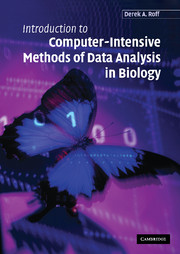Book contents
- Frontmatter
- Contents
- Preface
- 1 An Introduction to Computer-intensive Methods
- 2 Maximum Likelihood
- 3 The Jackknife
- 4 The Bootstrap
- 5 Randomization and Monte Carlo Methods
- 6 Regression Methods
- 7 Bayesian Methods
- References
- Appendix A An Overview of S-PLUS Methods Used in this Book
- Appendix B Brief Description of S-PLUS Subroutines Used in this Book
- Appendix C S-PLUS Codes Cited in Text
- Appendix D Solutions to Exercises
- Index
- References
5 - Randomization and Monte Carlo Methods
Published online by Cambridge University Press: 09 December 2009
- Frontmatter
- Contents
- Preface
- 1 An Introduction to Computer-intensive Methods
- 2 Maximum Likelihood
- 3 The Jackknife
- 4 The Bootstrap
- 5 Randomization and Monte Carlo Methods
- 6 Regression Methods
- 7 Bayesian Methods
- References
- Appendix A An Overview of S-PLUS Methods Used in this Book
- Appendix B Brief Description of S-PLUS Subroutines Used in this Book
- Appendix C S-PLUS Codes Cited in Text
- Appendix D Solutions to Exercises
- Index
- References
Summary
Introduction
Monte Carlo methods are used extensively in this book to generate models with which to illustrate or test particular statistical models or approaches. A Monte Carlo model is one in which there are one or more random components, e.g., the model y = x + ε, where ε is some randomly distributed variable. Kendall and Buckland (1982) define the Monte Carlo method as a method that denotes “the solution of mathematical problems arising in a stochastic context by sampling experiments … the solution of any mathematical problem by sampling methods: the procedure is to construct an artificial stochastic model of the mathematical process and then to perform sampling experiments on it.” In this chapter, I restrict my attention to the use of a Monte Carlo model to test a given statistical hypothesis. Randomization and the bootstrap can be considered as particular forms of the Monte Carlo method but their extensive and increasing use promote them to statistical methods in their own right. Monte Carlo models tend to be “tailor-made” for the particular problem under study, whereas the bootstrap and randomization methods can be more readily generalized, as illustrated in the last chapter by the routines now available on many computer software packages. Therefore, I shall first discuss randomization and then Monte Carlo techniques in general.
Randomization is first and foremost a technique for hypothesis testing, though it is possible to use it to construct confidence limits. Because of the few constraints it places upon the data, randomization is an extremely useful method.
Information
- Type
- Chapter
- Information
- Publisher: Cambridge University PressPrint publication year: 2006
References
Accessibility standard: Unknown
Why this information is here
This section outlines the accessibility features of this content - including support for screen readers, full keyboard navigation and high-contrast display options. This may not be relevant for you.Accessibility Information
- 1
- Cited by
